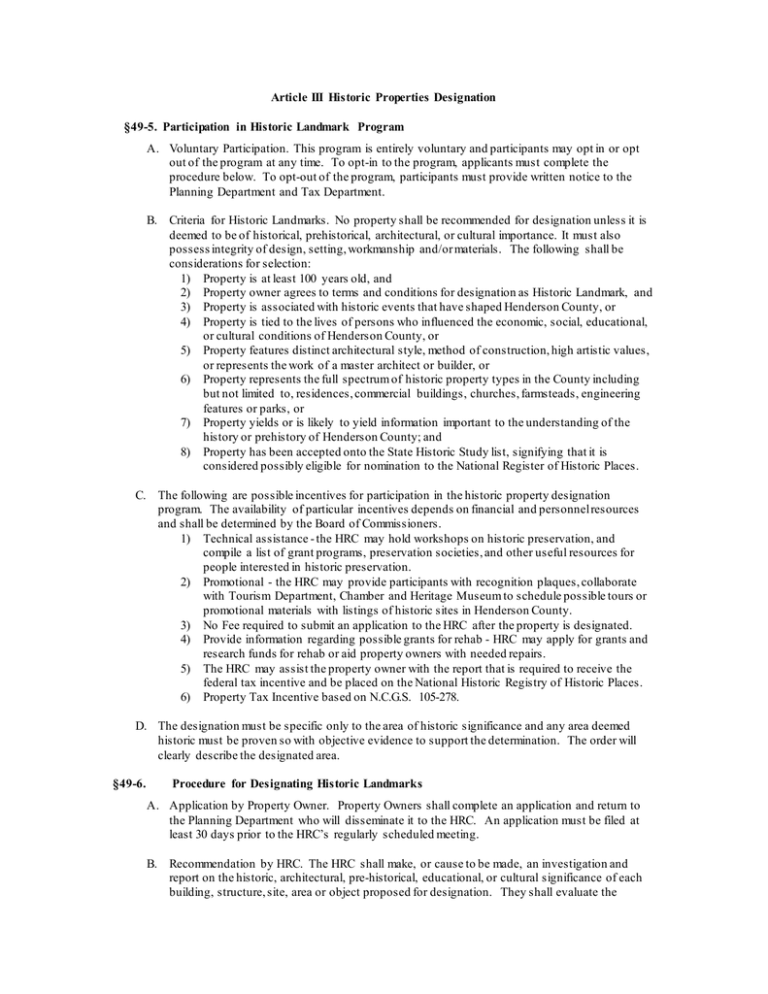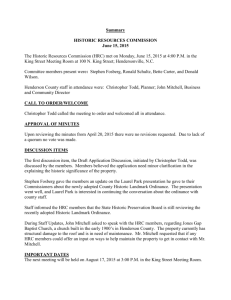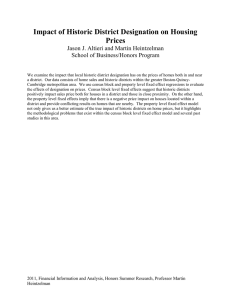Article III Historic Properties Designation §49
advertisement

Article III Historic Properties Designation §49-5. Participation in Historic Landmark Program A. Voluntary Participation. This program is entirely voluntary and participants may opt in or opt out of the program at any time. To opt-in to the program, applicants must complete the procedure below. To opt-out of the program, participants must provide written notice to the Planning Department and Tax Department. B. Criteria for Historic Landmarks. No property shall be recommended for designation unless it is deemed to be of historical, prehistorical, architectural, or cultural importance. It must also possess integrity of design, setting, workmanship and/or materials. The following shall be considerations for selection: 1) Property is at least 100 years old, and 2) Property owner agrees to terms and conditions for designation as Historic Landmark, and 3) Property is associated with historic events that have shaped Henderson County, or 4) Property is tied to the lives of persons who influenced the economic, social, educational, or cultural conditions of Henderson County, or 5) Property features distinct architectural style, method of construction, high artistic values, or represents the work of a master architect or builder, or 6) Property represents the full spectrum of historic property types in the County including but not limited to, residences, commercial buildings, churches, farmsteads, engineering features or parks, or 7) Property yields or is likely to yield information important to the understanding of the history or prehistory of Henderson County; and 8) Property has been accepted onto the State Historic Study list, signifying that it is considered possibly eligible for nomination to the National Register of Historic Places. C. The following are possible incentives for participation in the historic property designation program. The availability of particular incentives depends on financial and personnel resources and shall be determined by the Board of Commissioners. 1) Technical assistance - the HRC may hold workshops on historic preservation, and compile a list of grant programs, preservation societies, and other useful resources for people interested in historic preservation. 2) Promotional - the HRC may provide participants with recognition plaques, collaborate with Tourism Department, Chamber and Heritage Museum to schedule possible tours or promotional materials with listings of historic sites in Henderson County. 3) No Fee required to submit an application to the HRC after the property is designated. 4) Provide information regarding possible grants for rehab - HRC may apply for grants and research funds for rehab or aid property owners with needed repairs. 5) The HRC may assist the property owner with the report that is required to receive the federal tax incentive and be placed on the National Historic Registry of Historic Places. 6) Property Tax Incentive based on N.C.G.S. 105-278. D. The designation must be specific only to the area of historic significance and any area deemed historic must be proven so with objective evidence to support the determination. The order will clearly describe the designated area. §49-6. Procedure for Designating Historic Landmarks A. Application by Property Owner. Property Owners shall complete an application and return to the Planning Department who will disseminate it to the HRC. An application must be filed at least 30 days prior to the HRC’s regularly scheduled meeting. B. Recommendation by HRC. The HRC shall make, or cause to be made, an investigation and report on the historic, architectural, pre-historical, educational, or cultural significance of each building, structure, site, area or object proposed for designation. They shall evaluate the information presented and give a recommendation that will be presented to the Zoning Board of Adjustment as part of the record for the quasi-judicial proceeding. C. Review by State Department of Cultural Resources Historic Preservation Office. The HRC’s report will be sent to the State Department of Cultural Resources Historic Preservation Office who will have 45 days following receipt of the report to review and provide written comments upon the substance and effect of the designation. These written comments shall be included in the evidence before the Zoning Board of Adjustment. D. Quasi-judicial proceeding before Zoning Board of Adjustment (ZBA). The ZBA shall review all relevant information and hear testimony from interested parties in a quasi-judicial proceeding. i. Newspaper Notice. Notice of the hearing (if required) shall be published in a newspaper of general circulation in the County at least once. The notice shall be published at least ten (10) but not more than twenty-five (25) days prior to the date fixed for the hearing. ii. Mailed Notice. Written notice of the hearing (if required) shall be mailed to all owners and occupants of properties at least ten (10) but not more than twentyfive (25) days prior the date fixed for the hearing. iii. Order. The order shall describe each property designated, the name or names of the owner or owners of the property, those elements of the property that are integral to its historical, architectural or prehistorical value and a waiting period prior to any structural demolition on the site. An entire parcel, including land and any structures will not be designated unless an explicit explanation of the whole parcel’s historic significance is provided at the time of designation. Each order must specify what the historic components of the designated property are and only those will be subject to this Ordinance and receive any benefit under N.C.G.S. 105-278. E. Approval by Board of Commissioners of Historic Landmark Designation Order. (1) Approval. The Board of Commissioners shall review the order prepared by the Zoning Board of Adjustment, any relevant evidence, the report by the HRC and the comments from the Department of Cultural Resources Historic Preservation Office in making its decision. (2) The Board of Commissioners may hold a public hearing regarding the application. F. Recording and Notice of Historic Designation. (1) Written notice of designation shall be provided to owners and occupants of each approved landmark. (2) Copies of the designation shall be recorded with the County Register of Deeds. (3) Notice of the designation shall be provided to the Clerk and to the Board of Commissioners. (4) A suitable sign for each property may be placed on the property with the owner's consent and must adhere to the Land Development Code sign requirements. §49-7. Certificate of Appropriateness A. Once a property is designated, it must receive a certificate of appropriateness for certain exterior modifications, alterations, or additions to the historic landmark. B. Such a certificate is required to be issued by the ZBA, after review by the HRC, prior to the issuance of a building permit or other permit granted for the purposes of constructing, altering, moving or demolishing structures, which certificate may be issued subject to reasonable conditions necessary to carry out the purposes of this article. A Certificate of Appropriateness shall be required whether or not a building or other permit is required. C. Minor works, as defined below, may be administratively approved and these decisions may be appealed to Superior Court. D. Applications for a certificate of appropriateness shall be obtained from and, when completed, filed with the Planning Department and filed at least 30 days prior to a regularly scheduled meeting of the ZBA. E. §49-8. Each application shall be accompanied by sketches, drawings, photographs, specifications, descriptions and other information of sufficient detail to clearly show the proposed exterior alterations, additions, changes or new construction. The names and mailing addresses of property owners filing and/or subject to the application must also be filed. No application which does not include the aforementioned information will be accepted. Standard for appropriate change The County shall take no action under this article except to prevent the construction, reconstruction, alteration, restoration, moving or demolition of buildings, structures, appurtenant features, outdoor advertising signs or other significant features which would be incongruous with the special character of the historic landmark. Changes must comply with the Henderson County historic properties design guidelines. §49-9. Certain changes not prohibited Nothing in this article shall be construed to prevent the ordinary maintenance or repair of any exterior architectural feature on a landmark which does not involve a change in design, materials, or outward appearance thereof; the ordinary maintenance or repair of streets, sidewalks, pavement markings, street signs, or traffic signs; [or] the construction, reconstruction, alteration, restoration or demolition of any such feature which the building inspector shall certify is required by the public safety because of an unsafe or dangerous condition. Nothing herein shall be construed to prevent the maintenance or, in the event of an emergency, the immediate restoration, of any existing above-ground utility or structure without approval by the ZBA. §49-10. Routine Maintenance, Minor Improvements & Major Modifications A. Routine Maintenance: The following activities are routine maintenance and do not require a certificate of appropriateness. (1) Interior work or painting. (2) Replacement of window glass and sash, as long as window size, style, and material are not altered. (3) Caulking and weather-stripping. (4) Landscape maintenance. (5) Real estate and political signs. (6) Repairs to walks, patios, fences, and driveways as long as replacement materials match the existing materials. (7) Replacement of small amounts (50% or less) of missing or deteriorated siding, trim, roof shingles, porch flooring, steps, gutters and downspouts, etc., as long as the replacement materials match the existing materials. B. Minor Improvements: Minor improvements to structures require a certificate of appropriateness. Minor modifications, listed below, may be administratively approved by the Planning Department. (1) Installation of storm windows and doors . (2) Side- and rear-yard fences and walls not facing a public street. (3) Installation of exterior mechanical equipment such as roof fans, heat pumps, and air compressors. (4) Repairs to walls, patios, fences, and driveways as long as replacement matches what presently exists. (5) Repairs to vents and access doors of foundation. (6) Replacement of exterior stairs, landings, and steps. (7) Replacement of large amounts (more than 50%) of missing or deteriorated siding, trim, porch floors, windows, and gutters or architectural details where there is no change in materials and design of original. (8) Re-pointing and other masonry repairs. (9) Exterior lighting fixtures. (10) Removal of asbestos or other artificial siding. (11) New roof coverings using shingles appropriate to the original. (12) Installation of satellite dishes. (13) Exterior paint removal. C. Major Modifications: Major modifications listed below require certificate of appropriateness approved by the ZBA after review and recommendation by the HRC. (1) Exterior changes including types or styles of windows, doors, porches, decks, roofs, and lighting fixtures. (2) Alterations in exterior architectural details. (3) The installation on any structure, of vinyl or aluminum siding or of any siding different than the existing siding. (4) The disturbance of designated archaeological sites. (5) The construction of any addition to an existing structure, such as the addition of rooms, chimneys, porches, decks, ramps, solar panels, and skylights, or any new construction. (6) The construction or placement of any outbuilding on the property, including carports, garages, utility sheds barns, silos, drying sheds, and bulk barns. (7) Relocation of a primary structure. (8) The placement or construction of any yard fixtures such as lamp posts or other lighting fixtures, walkways, fences or walls, driveways, parking areas or the placement of any physical structure which could be considered ornamental. (9) The demolition or removal of any structure, including outbuildings and yard fixtures. (10) The installation of any permanent exterior sign measuring larger than three (3) square feet in area. (11) Foundation repairs other than vents and access doors. §49-11. Compliance Assessment A. Compliance with the terms of the Certificate of Appropriateness shall be enforced by the Planning Department. Failure to comply with the Certificate of Appropriateness shall be a violation of the zoning ordinance. B. In case any building, structure, site, area or object designated as a landmark is about to be demolished, whether as a result of deliberate neglect or otherwise, materially altered, remodeled, removed or destroyed, except in compliance with this article, the County Board of Commissioners, the municipal governing body, the HRC, or other party aggrieved by such action may institute any appropriate action or proceeding to prevent such unlawful demolition, destruction, material alteration, remodeling or removal, to restrain, correct or abate such violation, or to prevent any illegal act or conduct with respect to such a building or structure. §49-12. Appeals Appeals must be filed 30 days from the date of the decision. Decisions of the Zoning Board of Adjustment and the Board of Commissioners may be appealed to Superior Court. §49-13. Relocation The ZBA must issue a Certificate of Appropriateness for the move before any other necessary permits can be obtained. The HRC may provide a recommendation to the Zoning Board of Adjustment A. Proper documentation shall be made prior to relocation of a historic building, including documenting its original setting and context, photographs, site plans, other graphic materials, and/or written statements to record the existing site conditions as necessary. B. Contractors experienced in moving historic structures shall be enlisted to do the following: (1) Determine the structural condition of the property. (2) Coordinate with the utility companies and county and municipal departments. (3) Protect the structure from vandalism or weather damage during the move. (4) Minimize structural damage during the move. C. Relocation of a structure shall not diminish or damage existing historic landmark buildings. D. The HRC and ZBA shall be provided with a site plan for the proposed site features of the new setting, including information on accessory buildings, driveways, site lighting, and parking areas. §49-14. Demolition In considering a request for a certificate of appropriateness to demolish a structure within a historic landmark, the ZBA shall weigh the impact of the proposed demolition on the character of the historic landmark, as well as surrounding buildings. A. All alternatives to demolition shall be evaluated. B. Significant structure features shall be documented, including photographs and measured drawings completed to the standards established within the Historic American Buildings Survey. C. Prior to demolition, the property owner shall work to salvage usable architectural materials and features. D. There may be a delay in demolition of historic landmarks and buildings. The period of delay shall be reduced by the ZBA if it finds that the owner would suffer extreme hardship or be permanently deprived of all beneficial use or return from such property. The waiting period for demolition must be established in the original designation order and cannot exceed 365 days. § 49-15. Through 49-50. (Reserved)





